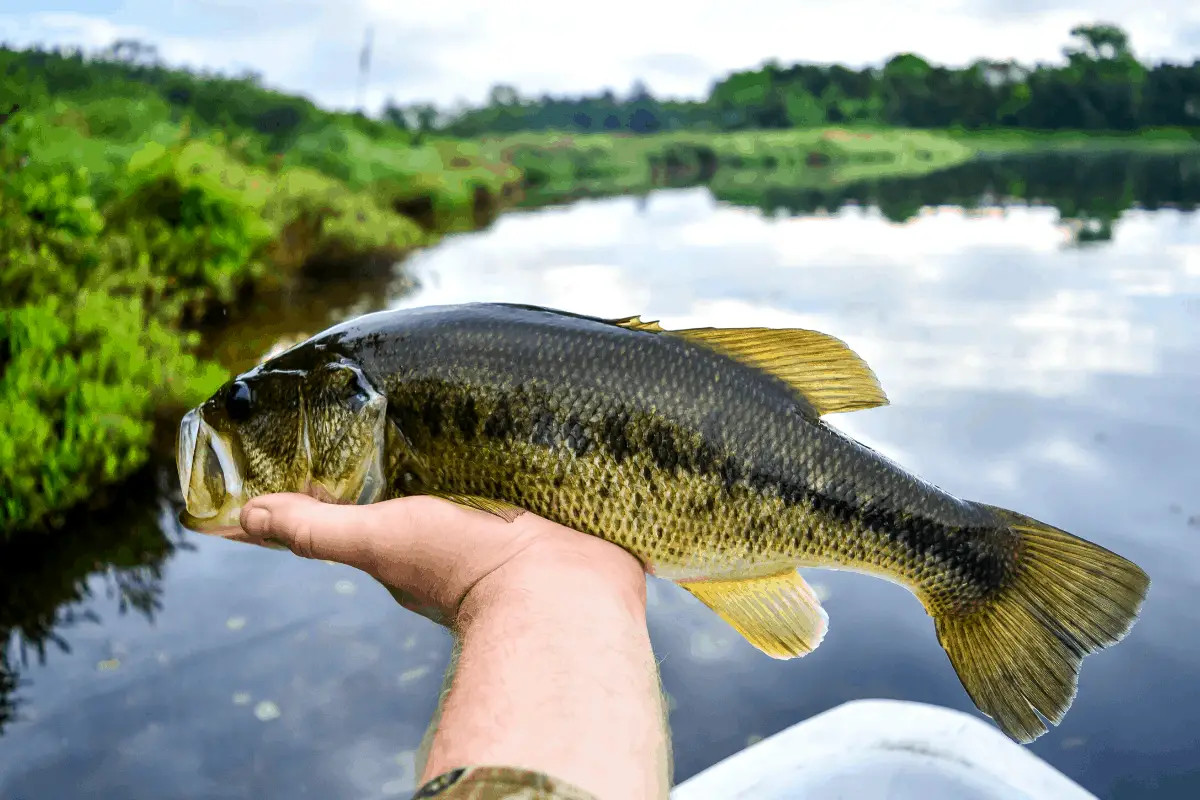Bass fishing is a sport enjoyed by millions of people annually. It brings together families, friends, and folks of multiple generations. This gamefish is so popular to pursue because of the variety of methods used to catch them and they can be found in nearly every body of water throughout North America.
What is a Bass?
There are numerous subspecies of bass, but the three that get the most attention are the largemouth bass, smallmouth bass, and spotted (Kentucky) bass. Each has a preferred habitat but all three adapt to a wide range of conditions. All three of these species are part of the black bass family.
Unlike some other predatory fish, a bass can sit in one place and still pull water through its gills providing needed oxygen. This allows bass to hide in cover waiting to ambush their prey.
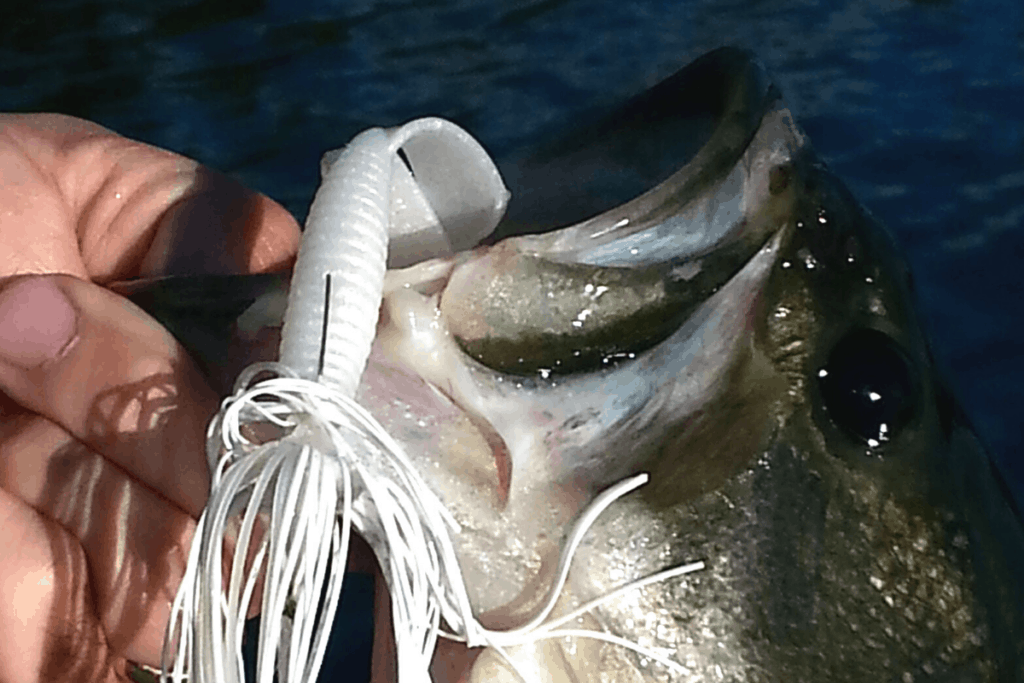
Largemouth Bass
This big bucket mouthed predator is the species most recognizable by nonanglers. It is largely green in coloration and is named because of its oversized mouth.
The jawline of a largemouth bass is set well beyond the eye and can open to a disproportionate size in comparison to the rest of its body. It is an opportunistic predator and its diet can range from terrestrials that hang near the water to about anything that swims. Largemouth bass will inhale frogs, small ducks, snakes, mice, and of course crawfish and a range of other fish.
Largemouth bass can be found in waters that range from ultra-clear to mud. They can also be found in a variety of water temps and can thrive in rivers, lakes, and ponds.
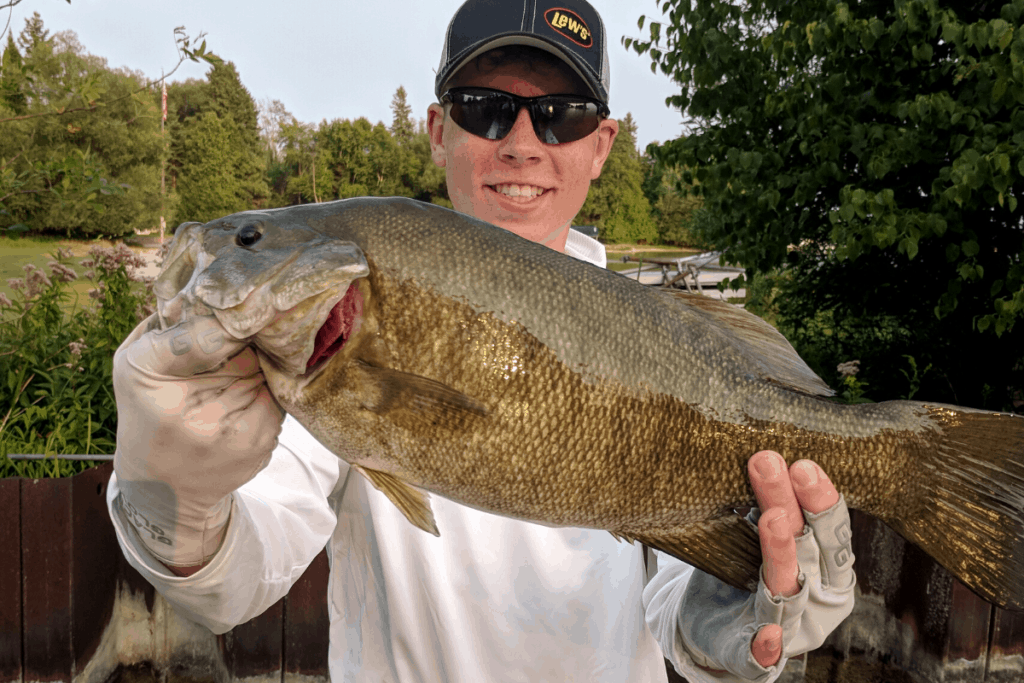
Smallmouth Bass
As their name suggests, the mouth on this variety of bass is smaller. The jawline does not protrude behind the eye and most smallmouth are relatively brown in color.
Many anglers call the smallmouth the “gamest fish alive.”
This is due to their fiery disposition and ability to put on quite the show when caught. I like to say that smallmouth are always angry.
This brown bass prefers to live in and around current and loves to hang near rocky structure. Crawfish are a major focus of their diet since they like to hang around rocks.
Like largemouth bass, smallmouth will eat all sorts of other creatures including other fish.
The smallmouth bass prefers clear water and cooler temperatures than its largemouth cousin. Smallmouth are also good indicators that a lake or river system is healthy and does not suffer from too much pollution.
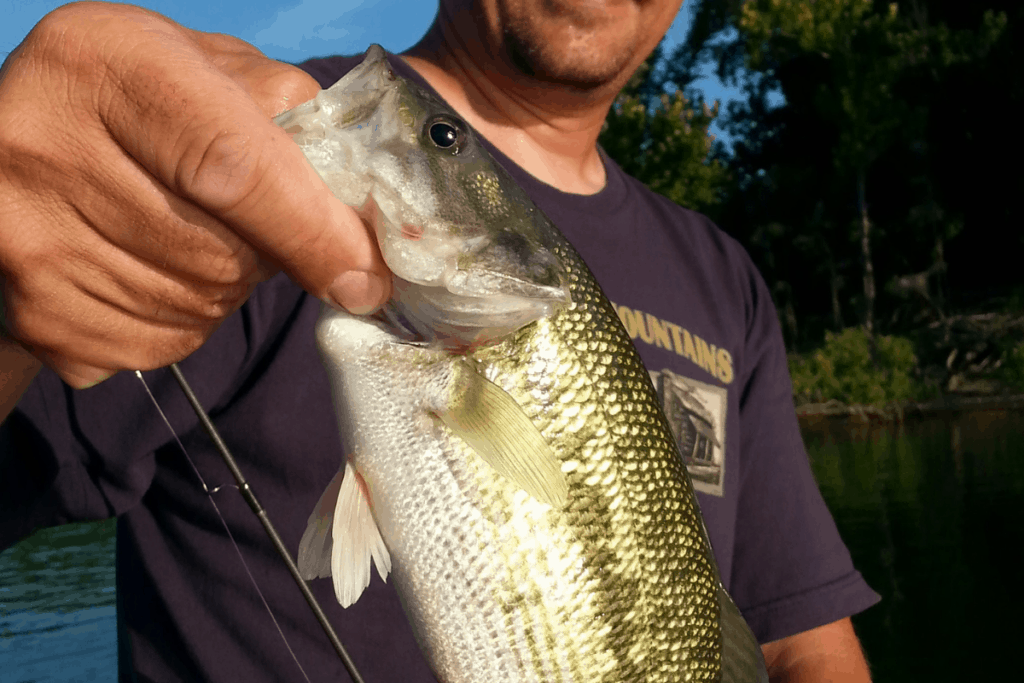
Spotted Bass
Spotted bass are often confused and misidentified as largemouth bass. They do look very similar in coloration and pattern, but there are some distinct differences.
First, the jawline does not extend past the eye like it does on a largemouth bass. Second, the lateral line is dotted with spots, giving the fish its name.
Spotted bass are most common in river systems in the central and southern portions of the United States. They have been introduced to some lakes and reservoirs and have done well.
Like largemouth and smallmouth, the diet of a spotted bass includes crawfish, other fish, and a variety of small crustaceans.
Size of Bass
The females of all three black bass varieties grow to be much larger than the males. While the world record weights are impressive, it is important to note that size and age are a direct result of the quality of habitat and abundance of food.
Largemouth especially, have been known to overeat and wipe out their own food sources causing death and starvation. In habitats that offer plenty of prey, all three bass can reach astonishing sizes that make them true trophies.
At the time of this writing, the world records for each are as follows:
Largemouth Bass World Record
In 1932, George Perry caught a 22lb 4oz beast from Montgomery Lake in Georgia. This record stood for nearly eight decades until it was tied.
In 2009, Manaba Korita caught a 22lb 5oz bass from Lake Biwa in Japan. Since the bass was not 2 ounces larger than the previous record, it is considered a tie.
Smallmouth Bass World Record
The current world record is steeped in controversy, but most authorities agree that David Hayes caught the world record in Dale Hollow Lake on July 9, 1955. The huge smallie weighed in at 11lb 15oz and solidified this Tennessee/Kentucky impoundment as a smallmouth mecca.
Spotted Bass World Record
The largest spotted bass on record comes from New Bullards Bar in northern California. Nick Dulleck is the proud record holder of this 11lb 4oz giant caught on February 12, 2017.
The previous record was also caught from this same impoundment making it a giant fish factory.
While these world records show how large these bass can get, it is much more common to catch all three of these gamefish that are in that 2lb – 5lb range.
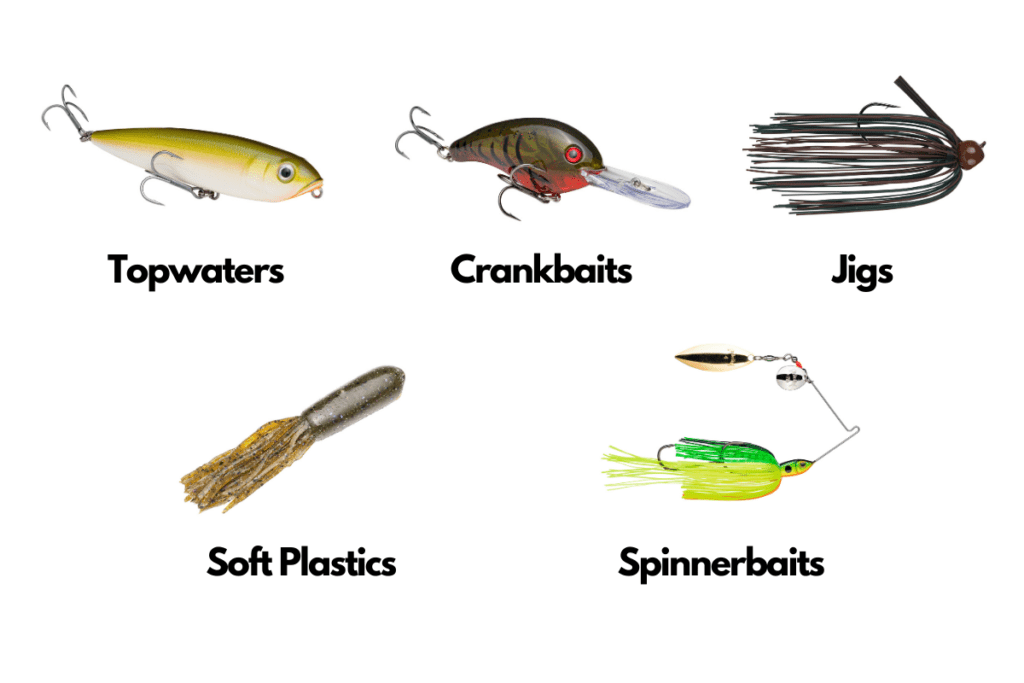
How to Catch a Bass
This is where it gets fun.
Of course, live bait can be used, but focusing on the wide-range of artificial lures that are available make catching bass something everyone can enjoy.
Bass can be caught in so many different ways. Artificial lures can be classified by the following categories: topwaters, crankbaits, soft plastics, jigs, and spinnerbaits. These are very general classifications with each one having a huge range of lures that can fall under them.
Topwaters
Most die-hard bass anglers will agree, catching a bass on a topwater might just be the most fun you can have while on the lake or river.
Topwaters, like their name suggests, are fished on the surface. They range from offerings that pop, splash, and models that move with an enticing side-to-side action.
Bass are opportunistic predators and when they see a potential meal struggling on the surface of the water they like to take advantage of the situation.
Many strikes are ferocious attacks that will knock the lure right into the air. The splash and commotion often startle the angler and instantly put an oversized smile on their face.
Ask any bass angler to show you their tackle collection and most will have a variety of topwater lures at their disposal.
Crankbaits
When I was a kid, this was the lure I started on. These baits are fished exactly like they sound.
You crank them.
Nearly every fishing lure manufacturer offers some sort of crankbait. These are designed to mimic either crawfish or baitfish and excel at bouncing off of cover.
You can pound them through rocks, bounce them off wood, and rip them through grass. The bill on a crankbait pitches the lure nose-down as it comes through the water. This bill shields the hooks from most of the objects that will hang them up.
The most productive crankbait anglers use these lures to elicit reaction bites by hitting everything they can as the lure is brought back to the boat.
Crankbait models range from those that can be fished in shallow water to giant versions that can dig down past the twenty foot mark.
There are wide-wobblers and tight-wigglers. They also come in about every color combination an angler could ever think of.
To be the most efficient with a crankbait it is desirable to pair it with a rod designed for this style of fishing.
Traditional crankbait rods are often made from a combination of graphite and fiberglass that gives it a more parabolic action that is less prone to yank the treble hooks from the fish. Savvy crankbait fishermen also tend to match a lower gear ratio reel with the setup as well so the lure is not retrieved too fast. A model anywhere from 5.2:1 – 6.2:1 is a good speed to use.
Soft Plastics
This single category of lures is so broad and varied that it is worthy of an entire article on its own.
Soft plastic bass lures mimic everything from baitfish, to crawdads, frogs, lizards, and anything else your mind can think up. The soft plastics aisle at major tackle retailers goes on-and-on.
What makes these particular lures so popular with bass anglers is the myriad of rigging options. It is easy to make soft plastic lures weedless and less apt to get hung up on brush, rocks, docks, etc.
The most popular way to hook soft plastics lures is with what is called a Texas Rig. This widely popular method utilizes a hook and often a worm weight.
Make sure when rigging your soft plastics, time is taken to keep the lure straight so it swims properly and maximizes the potential action the lure gives off.
For every type of plastic lure design, there are ten times that in color options. It can almost be overwhelming.
When in doubt, stick with natural colors and you will be well on your way to discovering a whole new world.
Jigs
Of all the lures in a bass angler’s tackle box, jigs might have the largest learning curve, yet it is worth the time.
Jigs are not only versatile baits that can be used all year, but they also have a tendency to get big bites from big fish.
The jig has seen many transformations over the years, but the essential style and shape has remained the same. A flipping and pitching jig is meant to be fished in thick cover. It can probe and search up big bass in locations that other lures have trouble with.
The overall compact size of a jig allows it to slip through small spaces and come through tight cover.
Most of the time, jigs are fished on the bottom and often mimic crawfish scooting around. Although, swim jigs are very popular and do an excellent job of imitating a variety of baitfish and prey species.
It take some time to get used to what a traditional jig bite feels like. It is often a small thump that signals a bass has inhaled the lure. The larger the bass the more likely the bite is almost imperceptible. The thump that we feel as anglers is actually the fish sucking the lure in like a vacuum.
Jigs are best fished on medium-heavy or heavy power rated rods. This stiffness, or backbone, of the rod transfers energy to the hook quickly so the fish can be pulled from cover before it turns and buries up in it.
Spinnerbaits
These versatile lures have been a staple in the bass fishing world for decades. Their wireframe design is perfect for holding blades that flash, thump, and attract the attention of hungry bass.
Spinnerbaits excel in horizontal presentations and can be thrown in and around all sorts of cover that holds bass.
Spinnerbaits most often imitate baitfish, but they can be rolled and thumped along bottom structure as well as be retrieved higher in the water column.
These lures are matched with several blade types: willow leaf, Colorado, and Indiana blades. The slender willow leaf blade is best when the conditions are sunny or the water is clear to slightly stained. The Colorado and Indiana blades are more circular in shape and provide more “thump” on cloudy days or in dirty water. This thumping action allows the lateral line on the side of the bass to detect the vibrations in the water.
While spinnerbaits do come in a range of colors, the whites and chartreuse combinations are some of the most popular.
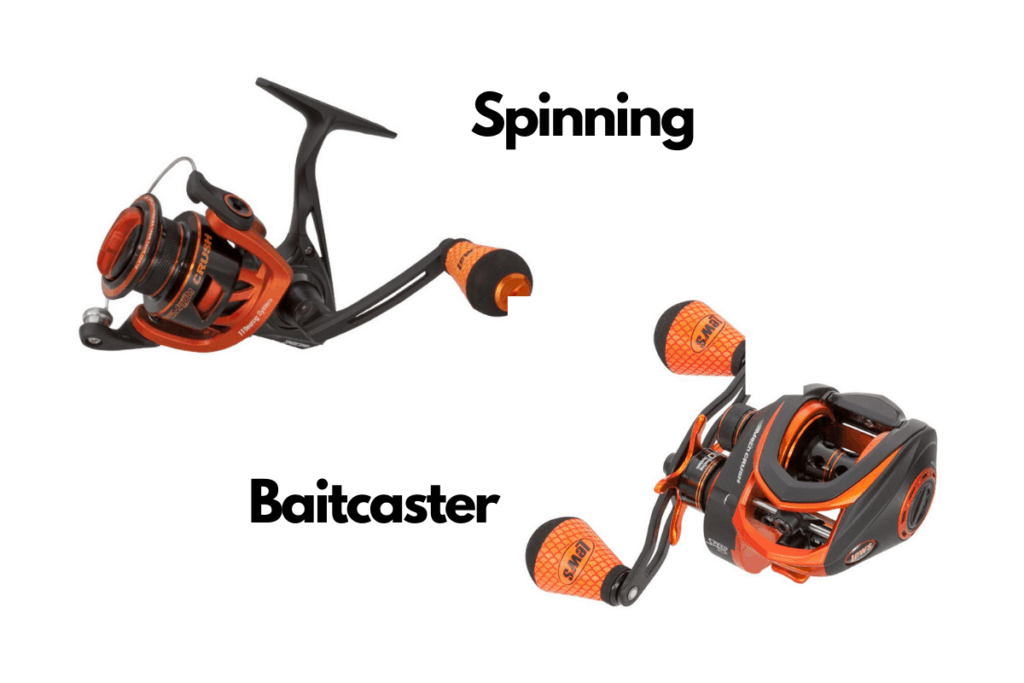
Rod and Reel Selection for Bass Fishing
Bass anglers typically focus on two types of rod and reel combinations: spinning gear and baitcasting gear.
Spinning Rod and Reel
Spinning gear is popular no matter how experienced a bass angler may be due to its ability to cast light lures effectively. It is typically used for finesse presentations that utilize small lures, light line, and is ideal for tough situations.
A spinning reel is also popular with anglers that are new or beginners to the sport since they are quite castable and do not require the practice that a baitcast reel does.
Most bass anglers use reels that are referred to as a size 200, 20, or 2500. Each manufacturer has their own numbering system, but traditionally a spinning reel of this size holds around 120 yards of 8lb monofilament line.
A spinning reel is paired with a spinning rod. A typical spinning rod will be anywhere from a medium light power rating to a medium heavy power rating.
Many finesse presentations, like drop shots, ned rigs, shaky heads, and small Texas rigged lures are best presented on spinning gear.
Baitcast Rod and Reel
Baitcast reels have been around for many, many decades. These casting reels require some practice to feel what it is like to maintain pressure with your thumb as the lure flies to its target.
The learning curve is worth the effort. Baitcast equipment allows for bass anglers to throw heavier lures with extreme accuracy. This type of equipment is also ideal for fishing in heavy cover that requires power to winch big bass to the boat.
While casting rods are available in a medium light power rating, most of them are rated from a medium to a heavy power rating. Take a look at the deck of a bass angler’s boat and you will likely find many casting rods that are medium heavy and heavy power rated.
Transition Phase
It is normal for beginning bass anglers to start out on spinning gear and transition to casting gear when their skill level and desire for more accuracy takes hold.
Professional bass anglers use both sets of tools and have specific rods and reels for niche techniques.
Rod Ratings
Fishing rods have a specific power rating and action rating listed on them. It is important to understand these ratings and how they are best suited for certain techniques.
Power Rating
Ultra Light: Best for lures in the 1/32oz to 3/8oz range. Used for panfish and ultra light presentations
Light: A rod with this power rating works well with lures in the 1/16oz range and is ideal for species with a light bite – like walleye and trout.
Medium Light: These rod are perfect for lures in the 3/8oz – 1/2oz range. Many bass anglers use these rods for ned rigs and drop shots.
Medium: A medium action rod can handle lures up to 1/2oz as well and is a favorite for bass anglers who like to throw crankbaits. A good crankbait rod will be a composite model that is a combination of graphite and fiberglass.
Medium Heavy: This rod can handle lures from 1/4oz – 3/4oz. This is the most common power rating used by bass anglers because of its versatility to handle a variety of lure sizes and presentations.
Heavy: This rod power rating can handle lures up to 1oz with ease – even heavier in some cases. These rods are designed for winching bass from heavy cover.
Extra Heavy: These rods are perfect for those giant lures, up to 2oz, and presentations that require a lure to punch through thick, matted vegetation.
Action Rating
Action refers to how quickly the tip of the rod gets to the “backbone.” A slow or medium action rod is going to have more flex at the tip of the rod and the stiff part of the rod will not kick in until it is past the fourth or fifth eye.
A fast or extra fast rod action gets to the backbone quickly and the rod will stiffen up between the second or third eye.
As a guideline, when bass fishing in thick cover, anglers want a fast or extra fast action rod to pull the bass out quickly. When fishing more open water with a horizontal presentation, like a crankbait, a medium action is ideal because it provides more flex and cushion when fighting the fish.
Are Expensive Rods Better?
This is a question nearly every angler asks at some point.
The goal of every rod manufacturer is to use as little material as possible while maintaining strength. This translates to a rod that is lightweight and sensitive. This better material costs more.
Inexpensive rods still catch fish, but they sacrifice sensitivity for a lower quality blank to hit certain price points at retail.
If the majority of an angler’s fishing is with horizontal presentations, like a crankbait, swimbait, or spinnerbait, odds are they can get by with a more price-point model and be satisfied.
If an angler focuses on bottom-bouncing techniques or likes to fish in heavy cover, a higher quality rod with greater sensitivity will make a noticeable difference.
When fishing with friends and family, ask them to try the equipment they are using – especially if someone has a higher price-point rod. This will give you an excellent idea of how the feel is different from a rod at the lower end of the retail pricing structure.
Where to Start Looking on a New Lake or River to Find Bass
Most beginning bass anglers prefer to fish in the milder or warmer weather from spring, through summer, and into the fall.
During this time period, there will always be fish that can be found shallow. The summer months will see a lot of bass move offshore and to deeper water, but there will still be some that remain in ten feet of water or less.
For beginning anglers, shallow fish are the easiest to target.
Look for any sort of cover that may provide a place for bass to hide and ambush their prey. Some typical cover that always holds bass includes: boat docks, aquatic vegetation, rocks, and wood.
If you are targeting smallmouth it is also best to find some sort of current if possible. Smallmouth will usually be in cleaner or clearer water as well. Largemouth can be found in water of any clarity.
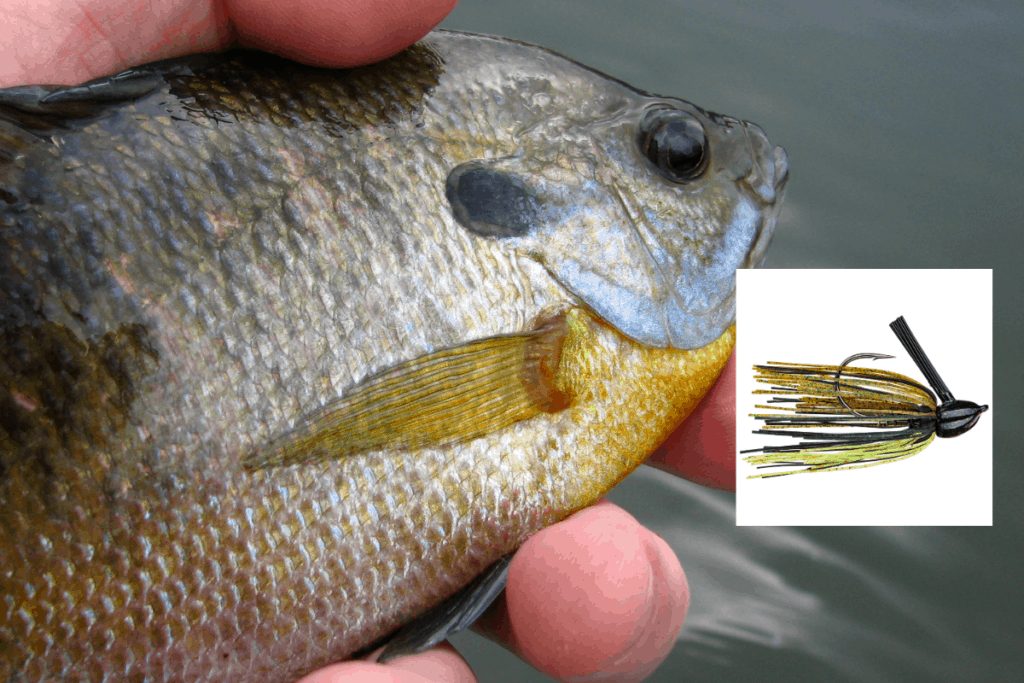
Match the Forage
With all the different offerings in regards to lures, keep it simple and match the forage that is in the water you intend to fish.
If you are not sure, crawfish and bluegills can be found in almost every body of water throughout the entire country. Mimicking these prey species is a good place to start.
Natural Presentations
When fishing with artificial lures, it is best to visualize that bait underwater. Try to present it in as natural a manner as possible.
Most creatures moves slowly and deliberately. It is easy to overwork the lures and fish them too fast.
If you have the chance, look at the lures in clear water and watch the movements as you impart action with the rod. It doesn’t take a large motion with your wrist to make that lure hop quite a distance. Keep this in mind when fishing.
Ask Questions
The great part about bass fishing is that there are so many lures, so many ways to fish them, and so many places to find bass. This variety also is what can make the sport seem overwhelming to new anglers.
Find people to fish with and don’t be afraid to ask them questions. A fishing mentor is a quick way to learn new skills and put fish in the boat.
Most bass anglers that I know love to help newcomers – no matter the age.
This era of social media also provides easy access to tens of thousands of bass fishing videos that can explain new techniques as you are ready for them.
Final Thoughts
Enjoy the process. You are on your way to an absolutely addicting hobby that is enjoyed by millions of people all around the world. Bass fishing is best enjoyed with friends and family members.
Take pride in the fact that every day on the water is another chance to learn new things and improve your skills. Bass anglers are always learning, always practicing, always getting better.
Who knows? You may enjoy the sport so much you go professional.
Be safe. Tight lines and remember to encourage someone today. You never know how you may change their life forever.
Isaiah 6:8

